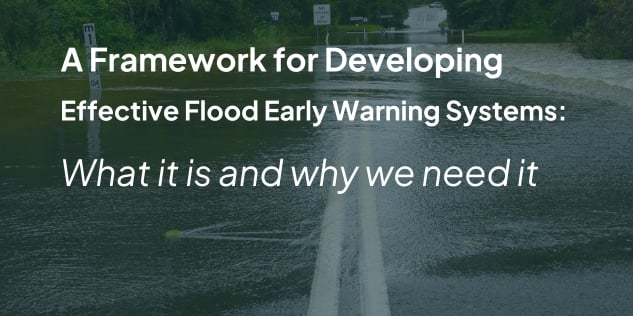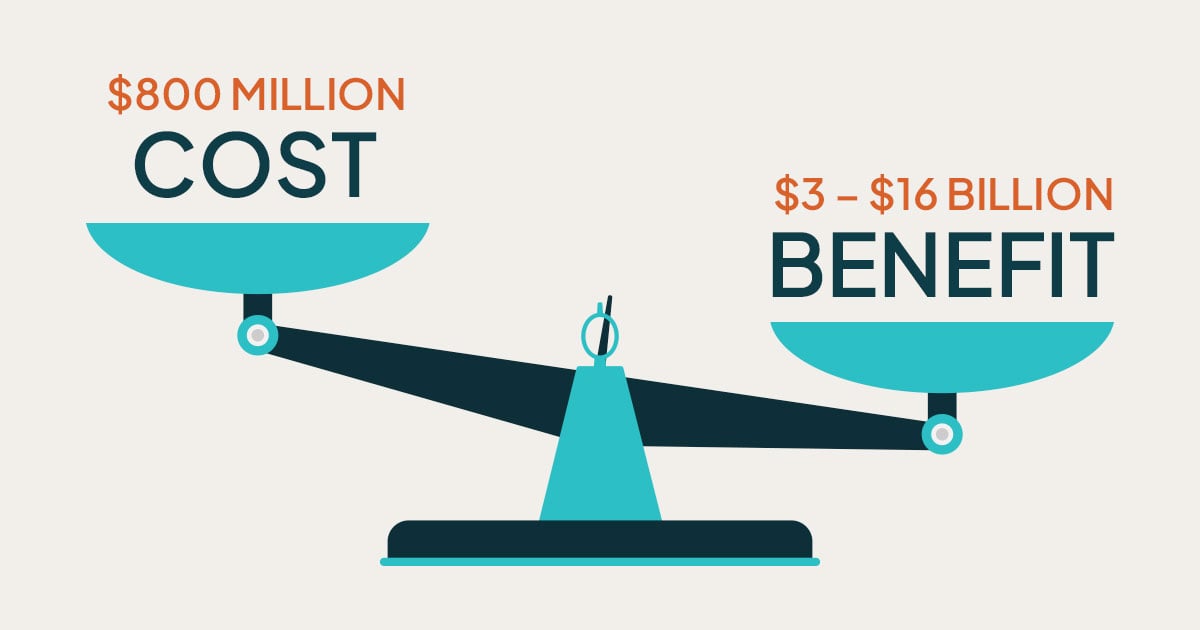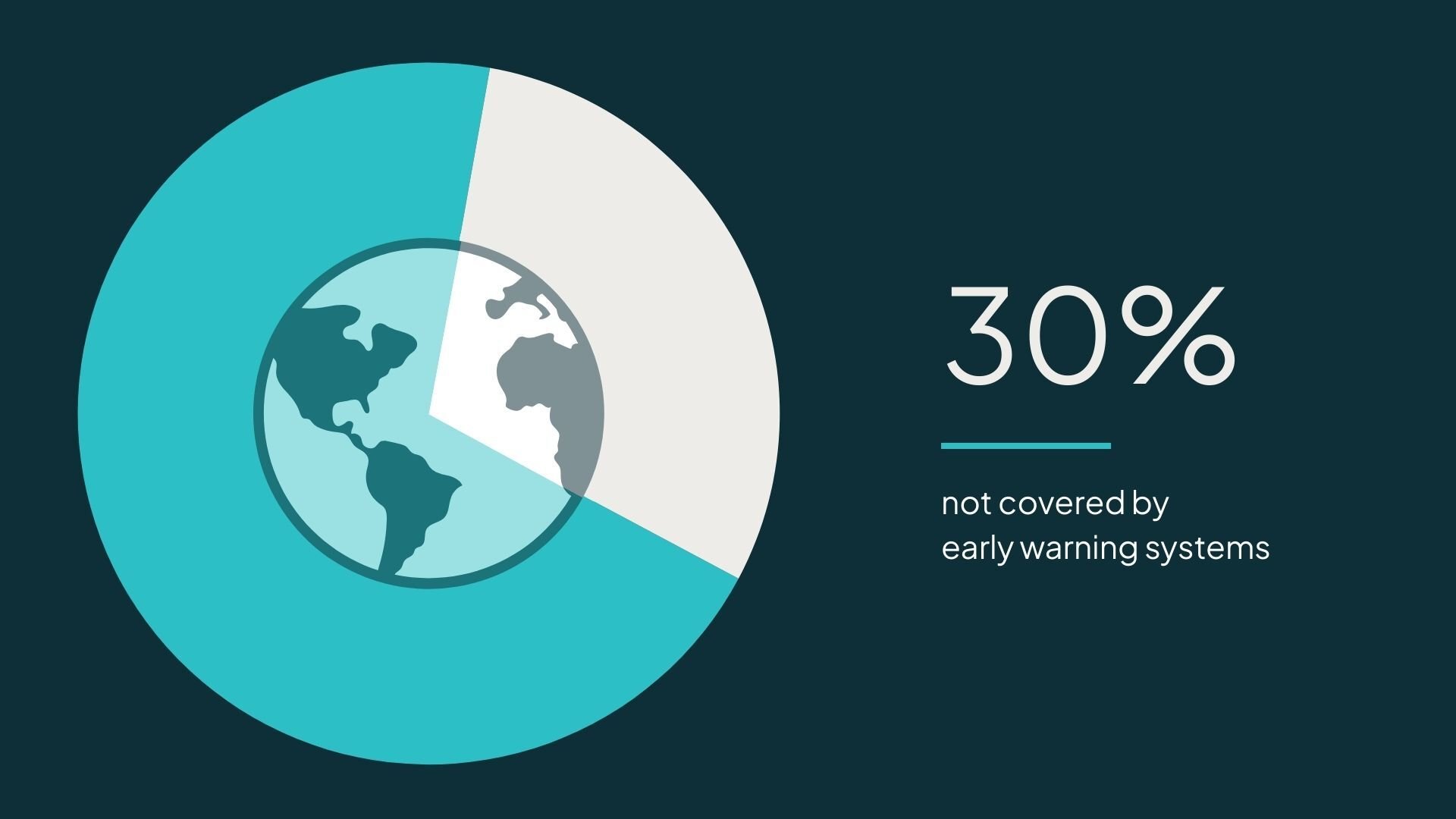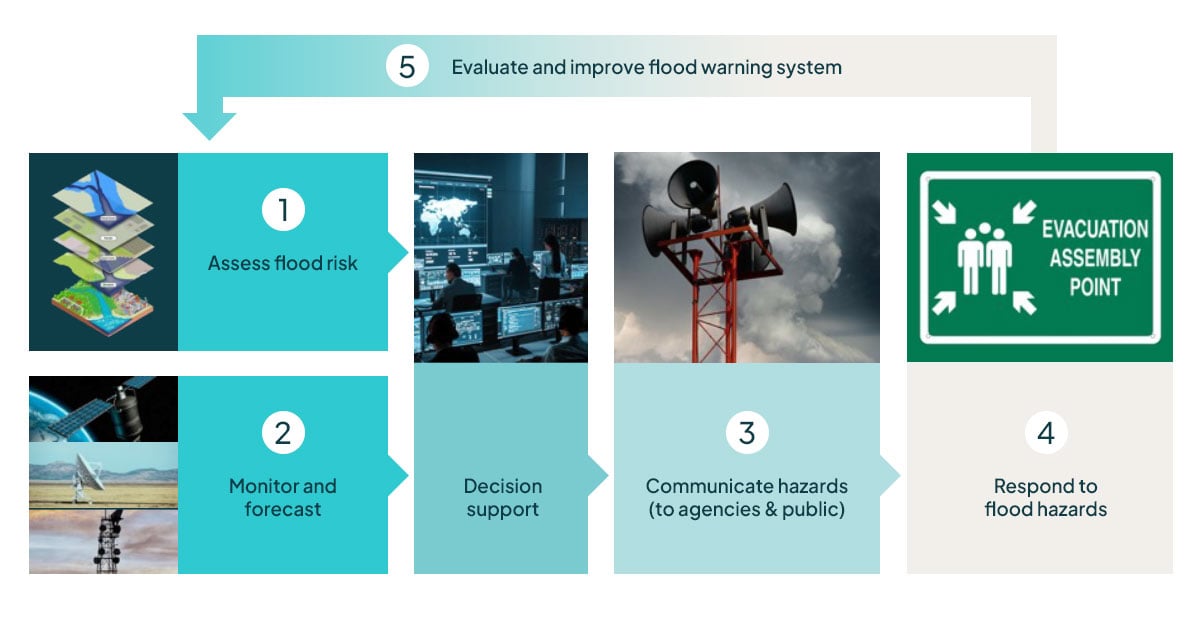
There is a clear need to expand coverage of flood warning systems while doing more to ensure the effectiveness of both new and existing systems.
Even as flood events continue to grow in both number and intensity, flooding already impacts more lives than any other type of natural disaster. Sadly, although flood early warning systems are among the most cost-effective means of mitigating the damage and casualties caused by flooding, many people still are not covered by a fully functional system.
The effort to ensure the effectiveness of flood warning systems will necessarily involve thinking about what those systems should look like. The challenge is that an ideal flood warning system is exceedingly complex. To overcome that challenge, we recommend a structured decision-making framework that ensures every facet of the system gets the attention it needs.
In what follows, we'll endeavor to answer each of the following questions:
- Why is flooding such a concern?
- How do flood early warning systems help?
- Who's actually covered by a fully functional flood warning system?
- What's a good framework for developing effective flood warning systems?

Flooding is a significant, growing problem
Flooding is the most prevalent form of natural disaster in the world with the most widespread impact on human populations. Floods account for about 43% of all natural disasters and about 45% of all people affected by natural disasters. That amounts to more than 2 billion people impacted by flooding worldwide.
And it's not just a coastal problem. For example, in the United States, flooding occurs on 8 out of every 10 days, and nearly half (48%) of the cumulative days with flood events are due to flooding in landlocked states.
Of course, all that flooding carries a high cost.
The World Meteorological Organization (WMO) looked at the top 10 most costly natural disasters from 1970 to 2019 and found that all of them were due to floods or hurricanes. (Although hurricanes may not technically be classified as flood events, flooding from their large waves and storm surge accounts for the biggest threat they post to life and property in coastal areas). Together, these 10 events alone accounted for US$636 billion.
And the problem is only getting worse. As of this writing, Texas just experienced its deadliest flood event since 1913. In fact, it's the deadliest flash flood event in the U.S. since 1976, even exceeding the death toll of Hurricane Helene.
As the climate becomes warmer, sea levels rise, more moisture enters the atmosphere, and the water cycle intensifies, the frequency and intensity of flood events are increasing. As a result, flood maps currently used by the Federal Emergency Management Agency (FEMA) to identify at-risk areas are already outdated, failing to include 50% of seriously flood-exposed structures. What's more, another study predicts that flood-related costs in the U.S. will rise another 24-29% by 2050, which would place future flood-related costs somewhere between US$37.8 billion and US$43.6 billion per year.
Early warning systems are cost-effective options to mitigate growing flood risks
There are a number of adaptive measures we can take to deal with natural hazards like floods. However, the WMO points out that early warning systems provide an especially "cost-effective and reliable" way of protecting lives, property, and infrastructure from natural disasters. According to findings from the United Nations Global Commission on Adaptation, investing just US$800 million in such systems in developing countries would prevent losses of US$3-$16 billion annually.

There's an obvious reason why early warning systems tend to be so effective. When citizens have more time between when they know a natural hazard is coming and when it actually occurs, they can use the extra time to secure property and get themselves to safety. In fact, the Global Commission on Adaptation found that a mere 24 hours of notice prior to an impending hazardous event can reduce damage by up to 30%.
If we focus specifically on early warning systems for floods, the potential benefits are equally impressive.
The World Bank commissioned a study pertaining to the costs and benefits of early warning systems for different types of natural disasters, and that study found a strong case in favor of early warning systems for floods. For example, 12 hours of notice prior to a flash flood could reduce damage by up to 60%; even a mere one hour of notice could reduce damage by as much as 20%. What's more, the mean benefit-to-cost ratio of flood early warning systems was 4.6 (with a range of 2.3 to 9.0). So, even with conservative estimates, flood early warning systems returned a positive benefit-to-cost ratio.
A different study looked specifically at the impact of a flood warning system on a particular region — the Lower Karnali River Basin in Nepal. That study concluded that the flood early warning system in this area had a benefit-to-cost ratio in the range of 24 to 73, depending on different scenarios. What's more, an improvement of just one hour in forecast lead times could increase current cost savings by 1.83 times.
Many still lack the protection of a fully functional flood early warning system
As important as early warning systems may be for mitigating flood risk, only about 70% of the world's population is covered by them. Alarmingly, these systems have even less reach in less developed countries. But even in North America, only about 83% of those who experienced a disaster in the past five years received at least one warning.

A case in point is Kerr County, which suffered an immense loss of life during the flash floods that recently devastated Texas. At the time of the floods, the county lacked a comprehensive flood early warning system. (The New York Times notes at least three separate occasions between 2017 and 2024 in which county officials sought and failed to secure funding for such a system.) The important point is that Kerr County is not unique. About 30% of the global population and about 20% of the North American population share the same vulnerability; many just haven't had to face a situation that would expose it...yet.
In light of the relatively low cost, high potential effectiveness, and lack of adequate coverage by early warning systems, the United Nations has set an ambitious target of expanding early warning systems to protect everyone on earth by 2027. While that goal may be challenging to reach, it clearly makes sense to expand coverage beyond today's levels.
But there's an important caveat to consider. Even when people are covered by a flood warning system, the system may not function correctly (and therefore may not provide the expected level of protection).
A new study appearing in the journal Geosciences begins by noting recent failures of flood warning systems in Germany, Pakistan, and New York. The study's authors conclude, "Flood incidents in the recent past have proved that both developing and developed nations are equally facing unexpected damages and losses due to the inadequacy of the linkage between warning providers and responders." They go on to identify no less that 24 critical failure factors.
So, in addition to expanding the coverage of flood warning systems, effort needs to go into ensuring that new and existing flood warning systems function effectively.
A framework for developing effective flood early warning systems
Whether it's designing a new system from the ground up or augmenting an existing system to make it more effective, it's important to begin with an understanding of what an ideal flood warning system would look like. Due to various external constraints, your community or business may decide later to compromise on the effectiveness of its flood warning system, but such decisions should be made with full awareness of the potential consequences.
An ideal flood warning system is complex. That's why it's important to have a framework that brings structure to the thought process to ensure that each facet of the system gets the attention it needs. At AEM, we subscribe to and recommend a framework that expands upon the internationally accepted four pillars of flood warning systems. That framework looks like this:

- Assess flood risk
Every early warning system needs to begin with an understanding of the risks it is intended to address. In the case of flooding, this means understanding (a) where areas are vulnerable to flooding, (b) how much rainfall it takes to produce flooding, (c) what property or infrastructure exists within the vulnerable areas, (d) how much advance notice would be needed by those in the vulnerable areas, (e) available evacuation routes, (f) available communication channels, etc.
For more about assessing flood risk, we have this webinar:
- Monitor and forecast
It's also important to monitor the variables that impact flooding. Obviously, this includes rainfall and water levels, but it may also include other variables, such as wind speed and wind direction in the case of some coastal flood zones. Hydrological and atmospheric models provide a critical lens for understanding the precise relevance of the various data points and their likely impact on flooding. To provide even more lead time, a flood warning system should also look at forecasted values for key variables like rainfall and water levels.
For a deeper dive into monitoring and forecasting flood threats, check out these two webinars:

- Communicate hazards
The entire point of identifying impending flood events before they occur is to communicate that information in a timely manner to those who need it. Who do you need to communicate with? Local agencies like fire, police, and public works? The general public? Maybe some combination of these? For communication with the general public, options include cellular, broadcast TV or radio, sirens, activated signage, or gate controls.
For an in-depth look at communicating flood threats to the public, you'll want to take a look at this webinar:
- Respond to flood hazards
It's important to ensure a tight connection between notification and emergency response. To that end, an effective flood warning system should include pre-planned actions for specific situations. - Evaluate and improve flood warning system
Every flood event provides an opportunity to examine what went right and what went wrong, so those in charge of the flood warning system can make appropriate changes and do things better the next time. Through this kind of iterative improvement, a flood warning system can continue to fine-tune its operations and get better over time.
For a deeper dive into the overall framework and how it can be applied to developing effective flood early warning systems, I encourage you to watch this webinar:
Next steps
Once you've mastered the framework, you can begin to apply it to real-life systems, including your own. You'll be in a stronger position to identify and expand upon best practices that you already may be employing, and you can better identify where your current system may be falling short.
Along the way, you may determine that you need a better understanding of your flood risks or that you need to improve upon your monitoring and forecasting. AEM offers hydrometeorological services, as well as hardware to help you keep tabs on weather, rainfall, and water levels. Perhaps you'll uncover gaps in how you currently disseminate information to your key stakeholders. Our AEM Elements® 360 platform enables you to consolidate all your flood-related data into one location for meaningful analysis and visualization while enabling customized alerts that can be sent automatically to your stakeholders.
Of course, we understand that all of this can feel quite overwhelming — even with a structured framework to guide your thinking. That's alright. The team at AEM is here to help. We offer deep expertise in network design and development. So, the best place to start would likely be a complimentary consultation with one of our team members.

